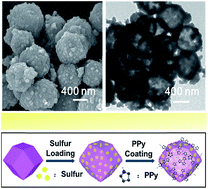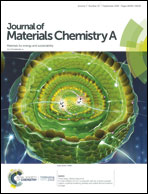Polypyrrole coated hollow metal–organic framework composites for lithium–sulfur batteries†
Abstract
Polypyrrole (PPy) coated hollow metal–organic framework (MOF) composites are synthesized through a simple melt-diffusion method followed by a water-phase dissolution process. Here, we used zeolitic imidazolate framework-67 (ZIF-67) as a precursor and then coated it with a PPy layer (ZIF-67-S-PPy) to prepare a lithium–sulfur battery (Li–S battery) electrode material. The special hollow structure can effectively inhibit device volumetric expansion caused by generated heat. Furthermore, this work also obtained a series of samples containing sulfur to explore the appropriate sulfur ratio. After electrochemical testing, the composites with a sulfur ratio of 60% achieved the highest specific capacity (1092.5 mA h g−1) among the tested samples, and 353.6 mA h g−1 remained after 200 cycles. The specific capacities of ZIF-67-S, S-PPy and sulfur without a host were 599.8 mA h g−1, 328.7 mA h g−1, and 364.8 mA h g−1, respectively, at 0.1C. The results indicated that the capacity of polymer-coated hollow MOF composite electrodes was obviously improved by the designed synthesis strategy, suggesting its potential for high-performance Li–S batteries.



 Please wait while we load your content...
Please wait while we load your content...